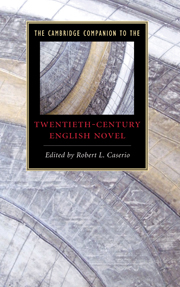Book contents
- Frontmatter
- Introduction
- 1 The art of English fiction in the twentieth century
- 2 The British Empire and the English modernist novel
- 3 Realism and rebellion in Edwardian and Georgian fiction
- 4 The Great War in English fiction
- 5 Postwar modernism in the 1920s and 1930s: The mammoth in the basement
- 6 Regionalism in English fiction between the wars
- 7 Ireland and English fiction
- 8 Feminist fiction
- 9 Working-class fiction across the century
- 10 World War II, the welfare state, and postwar “humanism”
- 11 The Windrush generation
- 12 History in fiction
- 13 Postmodernisms of English fiction
- 14 Detectives and spies
- 15 The post-consensus novel: Minority culture, multiculturalism, and transnational comparison
- 16 An absurd century: Varieties of satire
- 17 The other side of history: Fantasy, romance, horror, and science fiction
- Further reading
- Index
11 - The Windrush generation
Published online by Cambridge University Press: 28 July 2009
- Frontmatter
- Introduction
- 1 The art of English fiction in the twentieth century
- 2 The British Empire and the English modernist novel
- 3 Realism and rebellion in Edwardian and Georgian fiction
- 4 The Great War in English fiction
- 5 Postwar modernism in the 1920s and 1930s: The mammoth in the basement
- 6 Regionalism in English fiction between the wars
- 7 Ireland and English fiction
- 8 Feminist fiction
- 9 Working-class fiction across the century
- 10 World War II, the welfare state, and postwar “humanism”
- 11 The Windrush generation
- 12 History in fiction
- 13 Postmodernisms of English fiction
- 14 Detectives and spies
- 15 The post-consensus novel: Minority culture, multiculturalism, and transnational comparison
- 16 An absurd century: Varieties of satire
- 17 The other side of history: Fantasy, romance, horror, and science fiction
- Further reading
- Index
Summary
In the Anglophone world a West Indian literary renaissance came about in the 1950s because of the immigration of writers-to-be to Britain. Those writers were part of the “Windrush generation,” a popular designation for postwar immigration to the UK that derives from the name of a converted troopship, Empire Windrush, which began carrying West Indians and other emigrants to England in June, 1948. The Empire Windrush and the immigrant surge symbolize the beginning of contemporary multiracial and multicultural Britain, and a consequent reshaping of national identity. Windrush generation novelists, arriving in England between 1950 and 1959, include Samuel Selvon (1950), George Lamming (1950), V. S. Naipaul (1950), Roy Heath (1951), Andrew Salkey (1952), Roger Mais (1952), Michael Anthony (1954), and Wilson Harris (1959). They introduced new subject matter into representations of English life and new ways of thinking about English literary tradition.
To be sure, even before the postwar period West Indians and other British colonials with literary ambitions immigrated to England to find a forum for their work. West Indian C. L. R. James recalls in Beyond a Boundary a conversation in 1931 with famous cricketer Learie Constantine, who planned to emigrate, and remarks: “I too was planning to go to England as soon as I could, to write books.” This kind of immigration did not necessarily aim at rejection of some place or identity in exchange for a new one; but it almost always did involve surprising discovery and transformation. In 1931 Constantine and James had talked about almost nothing other than books and their shared passion for cricket; but five weeks after James's arrival in England, the friends began promoting the idea of West Indian self-government, having “unearth[ed] the politician in each other” (p. 116).
- Type
- Chapter
- Information
- The Cambridge Companion to the Twentieth-Century English Novel , pp. 163 - 175Publisher: Cambridge University PressPrint publication year: 2009
- 2
- Cited by

